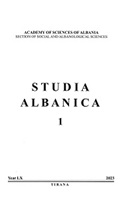PREHISTORIC METALLURGY DURING ENEOLITHIC AGE IN ALBANIA & KOSOVO
PREHISTORIC METALLURGY DURING ENEOLITHIC AGE IN ALBANIA & KOSOVO
Author(s): Adem BunguriSubject(s): Archaeology, Cultural history, Ethnohistory, Ancient World
Published by: SHKENCA Akademia e Shkencave e Shqipërisë
Keywords: Archaeological researches; Albany; prehistoric metallurgy;
Summary/Abstract: Archaeological researches in Albania prove that the beginnings of prehistoric metallurgy date back to very early stages, i.e. the fifth millenium BC. The earliest metallurgical material evidence come from the multilayered settlement of Maliqin Korça basin, where 26 working tools of copper, earth molds of chisels, sludge and copperslag left-overs were unearthedin the neolithic layer of Maliq Ila (renamed Maliq IIb)A similiar situation was also documented in Kosovo, largely in the settlement Hisar II (Suharekë) where, apart from some copper tools and a stone shape mold for casting rectangualar chisels, two ceramic vessels of type “Gießgefäß ” serving to cast the smelted copper into shape molds were also discovered.Referring to Eneolithic Age, one can talk on two independent metallurgical provinces: one in the Korça Basin (Maliq II) and the other in the Dukagjini Plateau (Suharekë). The accumulation of richness in the hands of metallurgists and merchants of metalproducts and the intensification of the socio-economic differentiation in the pre and protohistoric communities led to the ultimate break-away with the ancient tribal structures and the inclusion of the protohistoric period into the major socio-economic transformations, which went through the whole Eneolithic Age; these processes would be further deepened and stepped up during the Bronze and Iron Age.
Journal: Studia Albanica
- Issue Year: 2023
- Issue No: 01
- Page Range: 23-59
- Page Count: 37
- Language: English
- Content File-PDF

